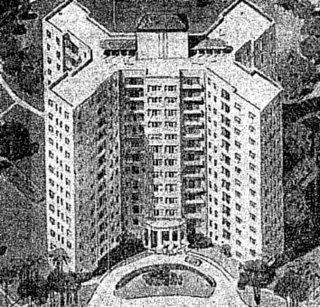
Chilmark Farms was a residential community in Westchester County, just 44 minutes (as the ad enticingly claims) from Grand Central Station. More interestingly, this 1938 ad from "House Beautiful" magazine assures the querulous home-buyer that the area is "unsullied by encroachments, fully improved, wisely restricted".
"Wisely restricted"---no one of color, naturally, but also no one of the Jewish persuasion.
In its dim past Park La Brea was also restricted. The first Jewish family to move to Park La Brea in 1944 was the Bernard Lisker clan, and they were only permitted to do so after the B'nai Brith and other Jewish advocacy groups implored management to create an exception to standard policy. Lisker's Los Angeles business was vital to WWII and housing was in short supply throughout the city.
A few years later Lisker was even named Park La Brea's father of the year. He's pictured in the Parklabrea News in June 1952 outside his Ogden Avenue apartment with children Perry and Barbara.

But Park La Brea remained restricted. Former Park La Brean Ellie Greenwood remembered having her lawyer (who was not Jewish) obtain the lease for her and her family. They lived in their Third Street apartment for years without having the lease in their own family name.
Enlightened times forced Met Life's hand and in 1963 they announced that African-Americans would be allowed to apply for a lease---"Negroes and other non-whites", they said, if qualified for tenancy, were welcomed to apply. This article is from the August 1963 Burlington NC Times-News.

Today Park La Brea reflects a reasonably enlightened attitude toward applicants, and one is thankful for that.




